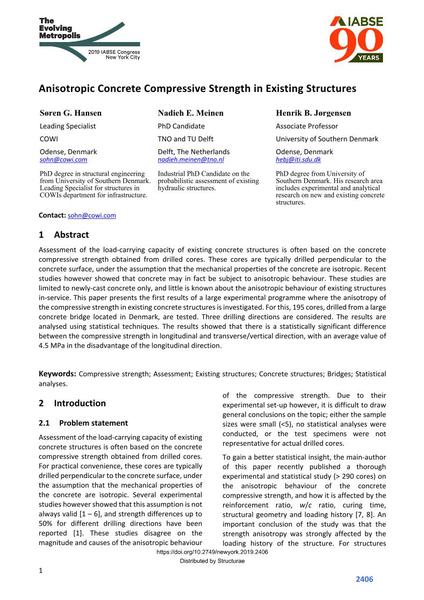Anisotropic Concrete Compressive Strength in Existing Structures

|
|
|||||||||||
Détails bibliographiques
| Auteur(s): |
Søren G. Hansen
(COWI)
Nadieh E. Meinen (TNO; TU Delft) Henrik B. Jørgensen (University of Southern Denmark) |
||||
|---|---|---|---|---|---|
| Médium: | papier de conférence | ||||
| Langue(s): | anglais | ||||
| Conférence: | IABSE Congress: The Evolving Metropolis, New York, NY, USA, 4-6 September 2019 | ||||
| Publié dans: | The Evolving Metropolis | ||||
|
|||||
| Page(s): | 2406-2412 | ||||
| Nombre total de pages (du PDF): | 7 | ||||
| DOI: | 10.2749/newyork.2019.2406 | ||||
| Abstrait: |
Assessment of the load‐carrying capacity of existing concrete structures is often based on the concrete compressive strength obtained from drilled cores. These cores are typically drilled perpendicular to the concrete surface, under the assumption that the mechanical properties of the concrete are isotropic. Recent studies however showed that concrete may in fact be subject to anisotropic behaviour. These studies are limited to newly‐cast concrete only, and little is known about the anisotropic behaviour of existing structures in‐service. This paper presents the first results of a large experimental programme where the anisotropy of the compressive strength in existing concrete structures is investigated. For this, 195 cores, drilled from a large concrete bridge located in Denmark, are tested. Three drilling directions are considered. The results are analysed using statistical techniques. The results showed that there is a statistically significant difference between the compressive strength in longitudinal and transverse/vertical direction, with an average value of 4.5 MPa in the disadvantage of the longitudinal direction. |
||||
| Mots-clé: |
ponts structures existantes
|
||||
